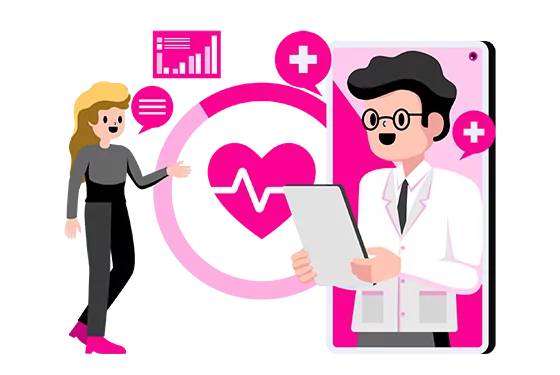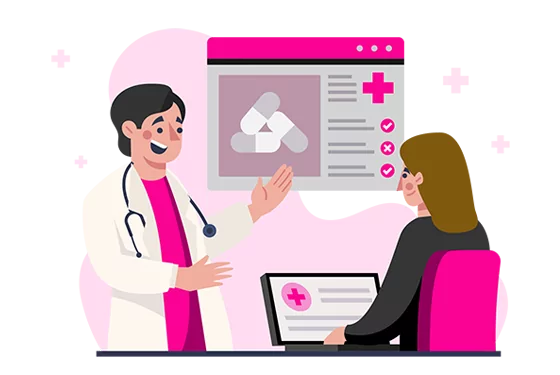Medical websites are not the ones to show off design flair for its own sake. These platforms are time-sensitive, emotionally charged, and often the first point of contact for someone in distress.
Therefore, the goal should be to create a simple, easy-to-navigate, and clutter-free user experience. A good medical web design shouldn’t scream for attention. Instead, it should quietly guide, inform, and reassure the patients.
The web design should respect the urgency of the moment and must be thoughtful. Would you like to know what else web design for healthcare should include? Here’s what’s missing and what to focus on!
Areas of Improvement in Medical Web Design
The healthcare industry wasn’t digitally sound before. It accelerated during the COVID period, with a surge in teleconsultation and online medicine delivery platforms. However, companies prioritized speed over user-centric design, leading to many areas needing improvements:
- A clunky interface
- Lacking responsive design
- Most didn’t focus on security
- Unclear or missing call-to-action buttons
- Cluttered structuring leading to poor navigation
- Consultation booking links are often buried or hard to find
- Lack of accessibility features, such as not being compatible with screen readers
Such oversights in medical web design can frustrate users and drive them away. It can lead to a higher bounce rate. This will not only diminish patient engagement but also tarnish the brand’s reputation as users often equate the website's poor performance with overall service quality.
Key Features for Medical Web Design
Your medical website shouldn’t confuse patients. Most users prefer a sleek, simple website that loads fast and is easy to use over a graphics-intensive website that is slow and confusing. Apart from that, your healthcare website should have:
HIPAA-Compliant Forms & Secure Patient Portals
Every healthcare website that collects patient data, be it for booking appointments or submitting medical history, must meet HIPAA compliance standards. This means using SSL encryption (HTTPS), secure servers, and access controls like two-factor authentication (2FA).
The patient portals, on the other hand, must have role-based access control (RBAC), audit logs, and automatic session timeouts to prevent unauthorized access. Similarly, forms should use field-level encryption and avoid storing protected health information (PHI) in plain text.
Also, the forms must be easy to fill out with clearly labeled fields, inline instructions, and real-time validation to reduce input errors.

In 2024, the number of global users of online doctor consultations surpassed 116 million, more than double the 57 million in 2019. This growth is due to physical restrictions during COVID-19, which made people shift to digital options for most needs, including medical care.
Therefore, to meet this rising demand, medical web design must integrate widely used telehealth tools. This could include secure video consultation, appointment scheduling, online chat, real-time prescription issuance, and follow-up systems.
Plus, users shouldn’t have to scour multiple pages to find these services. You can add a dedicated banner section prominently featured on the homepage, directing users to all available tools.
Physician & Location Directories

Additionally, featuring top-rated physicians for each location can guide patients toward highly regarded and rated doctors. The directory can also include filters based on doctors' specialties. To further enhance convenience, the website can have an option to book a consultation directly from the directory.
Patient Education & Blog

You can also incorporate internal links to service pages within blog posts. So, when a user searches for a medical query, reads the blog, and finds relevant information, they also have the option to instantly book an appointment or engage with other services. Therefore, streamlining their journey from education to action.


72% of patients read online reviews when choosing a new healthcare provider. The same percentage of patients prefer providers rated four stars or more. That implies that medical web design should prioritize testimonials and must display them prominently. They can be added either in text or video format. Similarly, case studies can be added to reassure the patients about the quality of care you provide.
How Can These Features Improve Your Website Reach?
User-friendly web design for healthcare isn’t just about aesthetics. It impacts website performance, user experience, engagement, and retention rate.
- Higher Conversions: Adding clear CTAs, online booking systems, and intuitive navigation can reduce friction. This increases conversions as users can easily access every feature.
- Strong Reputation: A secure, clutter-free, and professionally designed website loaded with accessibility features signals trustworthiness.
- Improved Customer Service: Integration of telehealth features, filtered physician directories, live chat, and blogs helps retain users on your platform. Once they get comfortable using your website, they’ll always prefer it over others.
If your medical web design feels outdated or isn’t meeting user expectations, now is the time for a strategic upgrade. At Synchronicity Designs, we audit, restructure, and rebuild websites to give your brand momentum in a competitive market.
We develop healthcare websites that align with patient needs and follow the highest industry standards. From initial discovery to launch, we focus on functionality, clarity, and results, so your website can do more than look good.
Want to rebuild or launch your medical website? Get in touch with us today!